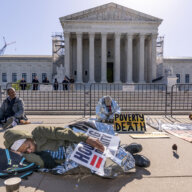 Rikard Larma/Metro. Protesters lined Broad Street ahead of the Schools Reform Commission Vote Thursday afternoon. Twenty-three schools will close. Four were spared.
Rikard Larma/Metro. Protesters lined Broad Street ahead of the Schools Reform Commission Vote Thursday afternoon. Twenty-three schools will close. Four were spared.
Twenty-three will close. Four have been saved.
The Schools Reform Commission (SRC), the state-appointed board that controls the school district, approved shuttering 23 public schools. Four schools—Thomas M. Peirce Elementary, Bayard Taylor, Roosevelt Theodore Middle School and Paul Robeson High School—are saved.
Two more school closures, M. H. Stanton and Beeber elementary schools, will be voted on later this year.
Since Superintendent William Hite first brought the plan forward in December 2012 planning to close 37 schools, community activists, elected officials, parents and teachers begged for a one-year freeze on school closings. In February, Hite reduced the number of closures from 37 to 29.
Thirty-four community activists spoke out at the conference Thursday against the closings. Christina Moresi, a graduate of the public school system, spoke on behalf of Robert Fulton Elementary.
Moresi said the schools are the cornerstone of the neighborhood. For some, the schools are the children’s safe haven, she said.
“If you knock down the schools,” she said, “you might as well build more prisons.”
Before the vote, multiple protestors were arrested outside the building, including American Federation of Teachers President Randi Weingarten.
Inside the auditorium, protestors locked arms and blocked entrances in an attempt to prevent the five-member board from voting. Nineteen protesters were arrested.
Hite, along with Mayor Michael Nutter and other SRC members, have long stood pat. The officials claim the district is broke and cannot bankroll empty classrooms and schools must close.
Hite has said the plan will save $24.5 million per year, minus transition costs.





























